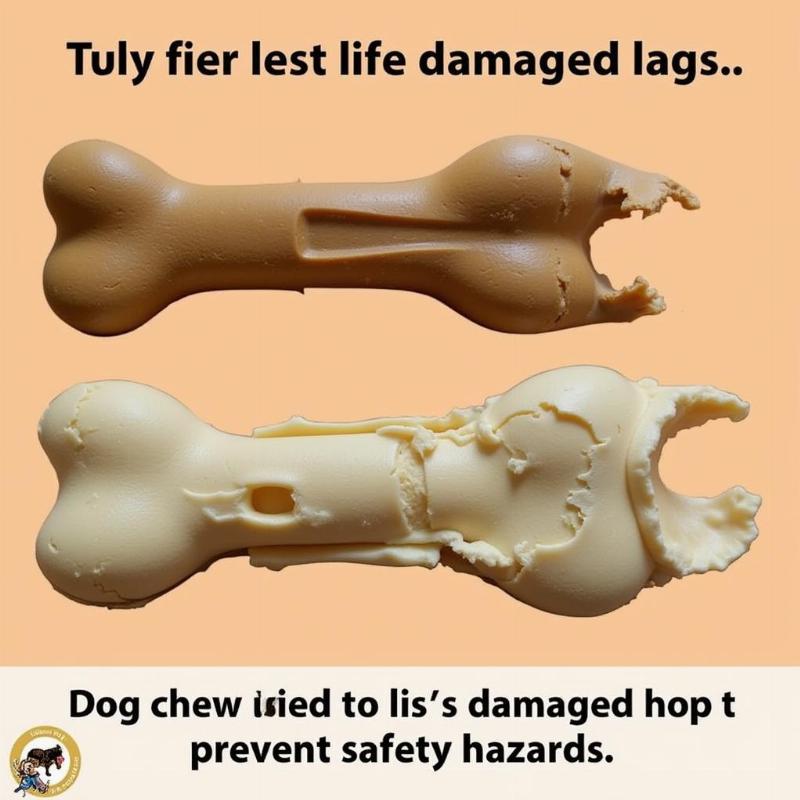Choosing the right chew toys for your dog is crucial for their health and happiness. Vet-recommended dog chew toys provide not only entertainment but also contribute to dental hygiene, relieve anxiety, and satisfy their natural chewing instincts. This article explores various aspects of selecting vet-recommended dog chew toys in the USA, ensuring safe and engaging playtime for your furry friend.
Why Choose Vet-Recommended Chew Toys?
Beyond simple amusement, vet-recommended chew toys offer a multitude of benefits for your canine companion. They help clean teeth and massage gums, reducing plaque and tartar buildup. Chewing can also alleviate boredom and anxiety, preventing destructive behaviors. Furthermore, these toys cater to a dog’s instinctual need to gnaw, promoting healthy jaw development and providing mental stimulation.
Types of Vet-Recommended Chew Toys
A variety of vet-recommended chew toys cater to different breeds, sizes, and chewing habits. From durable rubber toys for aggressive chewers to plush toys for gentler play, there’s an option for every dog.
- Rubber Chew Toys: These are often made from natural rubber and are ideal for aggressive chewers. Look for toys made in the USA with non-toxic materials.
- Rope Toys: These can help clean teeth and are great for interactive play like tug-of-war. Ensure the rope is tightly woven and made of durable, non-toxic fibers.
- Nylon Chew Toys: Known for their durability, nylon chews can withstand even the most powerful jaws. Choose those with varied textures and shapes for added interest.
- Treat-Dispensing Chew Toys: These combine the fun of chewing with the reward of treats, providing mental stimulation and encouraging positive chewing habits.
Choosing the Right Chew Toy for Your Dog’s Breed and Size
Selecting a chew toy based on your dog’s breed and size is vital for safety and enjoyment. A toy that is too small can be a choking hazard, while a toy that’s too large may be difficult for smaller dogs to handle. Consider the American Kennel Club breed standards for guidance on size and temperament. For example, a powerful chewer like a Rottweiler would benefit from a durable rubber toy, while a smaller breed like a Chihuahua might prefer a softer plush toy.
Material Safety and Durability: A Priority
Always prioritize chew toys made from non-toxic, durable materials. Look for toys made in the USA dog toys made in usa only as they often adhere to stricter safety standards. Avoid toys with small parts that could be ingested, and inspect toys regularly for signs of wear and tear.
How to Introduce a New Chew Toy to Your Dog
Introducing a new chew toy should be a positive experience. Start by showing your dog the toy and letting them sniff and explore it. You can encourage play by gently tossing the toy or engaging in a game of tug-of-war. Supervise your dog during initial play sessions to ensure they are using the toy appropriately and not attempting to swallow large pieces.
Chew Toys for Puppies: Encouraging Healthy Chewing Habits Early
Puppies have a strong urge to chew, especially during teething. Providing them with safe and appropriate chew toys can help them develop healthy chewing habits and prevent them from chewing on furniture or other household items. Soft rubber toys and teething rings can soothe sore gums, while plush toys offer comfort and companionship. gum numbing gel for dogs can also help soothe teething discomfort.
Signs of a Worn-Out Chew Toy: When to Replace
Regularly inspect your dog’s chew toys for signs of wear and tear. If a toy is ripped, torn, or has small pieces that could be ingested, it’s time to replace it. This prevents choking hazards and ensures your dog’s continued safety. safest long lasting chews for dogs are a good investment for dogs who are heavy chewers.
 Worn Out Dog Chew Toy
Worn Out Dog Chew Toy
Conclusion
Choosing vet-recommended dog chew toys is essential for promoting your dog’s overall health, happiness, and well-being. By selecting appropriate toys based on breed, size, chewing habits, and material safety, you can ensure safe and engaging playtime for your furry companion. Remember to regularly inspect and replace worn-out toys to prevent choking hazards.
FAQ
- What are the best vet-recommended chew toys for aggressive chewers? Durable rubber toys and nylon bones are excellent choices for aggressive chewers.
- Are rawhide chews safe for dogs? Rawhide can pose choking and digestive risks and is generally not vet-recommended.
- How often should I replace my dog’s chew toys? Replace toys as soon as they show signs of wear and tear, such as rips, tears, or missing pieces.
- Can chew toys help with my dog’s anxiety? Chewing can be a calming activity that helps alleviate anxiety and boredom in dogs.
- What are some good chew toys for puppies? Soft rubber toys, teething rings, and plush toys are suitable for puppies. dog bones that don’t splinter are also a safe option.
- How can I encourage my dog to use a new chew toy? Introduce the toy gradually, allowing your dog to sniff and explore it. You can encourage play by tossing the toy or engaging in a game of tug-of-war.
- What should I do if my dog swallows a piece of a chew toy? Contact your veterinarian immediately if your dog swallows a piece of a chew toy.
Beautdogs.us is your premier online resource for comprehensive and engaging information on dog care and companionship in the USA. We offer expert advice on dog breeds, grooming, nutrition, and product recommendations. Whether you’re a new dog owner or a seasoned expert, Beautdogs.us is your trusted source for all things dog-related. Contact us today for personalized guidance and support! Email: [email protected], Phone: +1 501-555-7529. Visit us at Beautdogs.us!